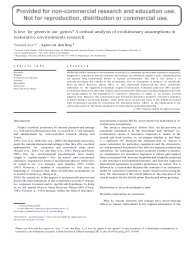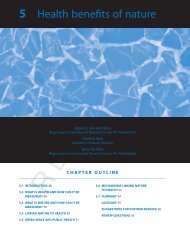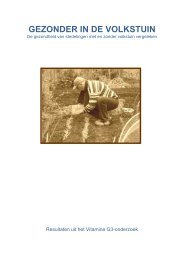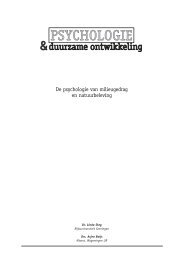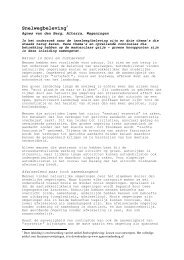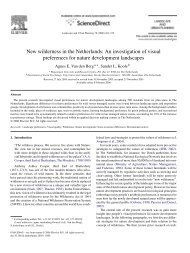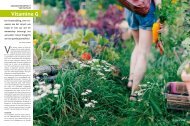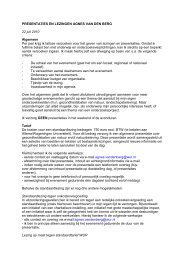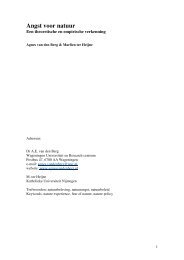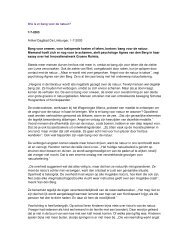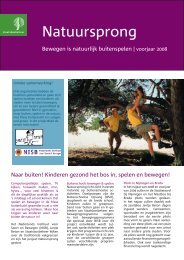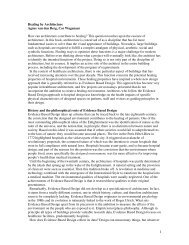healing environments in radiotherapy - Agnes van den Berg
healing environments in radiotherapy - Agnes van den Berg
healing environments in radiotherapy - Agnes van den Berg
You also want an ePaper? Increase the reach of your titles
YUMPU automatically turns print PDFs into web optimized ePapers that Google loves.
Heal<strong>in</strong>g Environments <strong>in</strong> Radiotherapy Project Report<br />
“A <strong>heal<strong>in</strong>g</strong> environment needs nature. If real nature can’t be there it should be simulated” (A. Kw<strong>in</strong>t,<br />
Plants for People). G. <strong>van</strong> Lagen from Casa Terra agrees; “if there are no w<strong>in</strong>dows, offer people a<br />
view of a nature image or for example an aquarium with fish and plants. Preferably there should be a<br />
dog or cat walk<strong>in</strong>g around or birds <strong>in</strong> a aviary.” The Care Hotel for Young Cancer Patients report also<br />
states that hospitals should feature some k<strong>in</strong>d of water attraction, as the sound of water can be<br />
calm<strong>in</strong>g for patients (Hesta, 2008). Bronson Methodist Hospital, for example, provides bubbl<strong>in</strong>g<br />
founta<strong>in</strong>s to create the calm<strong>in</strong>g sounds of water (Cassidy, 2003). Below is a picture of the aquarium <strong>in</strong><br />
one of the wait<strong>in</strong>g areas at the target hospital (figure 17).<br />
Figure 16: Aquarium at the target hospital<br />
However, plac<strong>in</strong>g liv<strong>in</strong>g plants, pets, aquaria or founta<strong>in</strong>s <strong>in</strong> hospital <strong>environments</strong>, especially <strong>in</strong><br />
treatment areas, is sometimes impossible for hygienic reasons. However, A. Kw<strong>in</strong>t from Plants for<br />
People refers to research that found that plants <strong>in</strong> hospitals do not lead to the feared <strong>in</strong>crease <strong>in</strong><br />
microorganisms <strong>in</strong> the air which is sometimes cited as a health concern <strong>in</strong> regards to <strong>in</strong>door plants <strong>in</strong><br />
hospitals. On the contrary, plants actually extract pollution from the air. Hence, he argues, it is safe<br />
to use plants <strong>in</strong> hospital sett<strong>in</strong>gs, as long as care is taken to avoid plants that are a common allergen<br />
(A. Kw<strong>in</strong>t, Plants for People). Nevertheless, hospital hygienists are often unwill<strong>in</strong>g to risk <strong>in</strong>fections or<br />
allergic reactions caused by plants. However, Van <strong>den</strong> <strong>Berg</strong> (2005) po<strong>in</strong>ts out that there is substantial<br />
evi<strong>den</strong>ce to show that images of nature on screen or on pictures can also promote relief from stress<br />
and pa<strong>in</strong>. For example, a study by Ulrich, Simons & Miles (2003) showed that blood donors had lower<br />
blood pressure and pulse on days when a wall mounted television displayed a videotape of natural<br />
sett<strong>in</strong>gs (a park and a stream) <strong>in</strong> the wait<strong>in</strong>g room, compared to days when the television displayed a<br />
videotape of urban sett<strong>in</strong>gs (a commercial street and shopp<strong>in</strong>g mall). Parson et al. (1998), conducted<br />
an experiment <strong>in</strong> which 160 stu<strong>den</strong>ts viewed one of four different nature dom<strong>in</strong>ated video-tapes<br />
while stress levels were measured <strong>in</strong> terms of elevated blood pressure and electro-dermal activity.<br />
Result showed that participants who viewed nature dom<strong>in</strong>ated videos showed quicker recovery from<br />
stress. Another video study by Tse et al. (2002) <strong>in</strong>vestigated 46 healthy volunteers who were<br />
22



